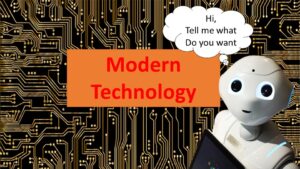Introduction
In today’s fast-paced world, technology has become an integral part of our daily lives. From smartphones and laptops to social media and video streaming platforms, technology has significantly impacted the way we communicate, work, and learn.
In the field of education, the impact of technology on modern education is significant, and it has the potential to revolutionize the way we learn. It has opened up new possibilities and opportunities for students to engage with course material, collaborate with peers, and access resources that were previously unavailable.
Impact of Integrating Technology in Education.
As technology continues to evolve, it has opened up new opportunities for students and educators alike. From online learning platforms to interactive whiteboards, technology has revolutionized the way we learn and teach.

Increasing Student Engagement and Motivation
1. Gamification:
Introduce gamified elements into the learning process, including badges, points, and progress tracking. This approach helps students stay engaged and motivated by providing a sense of accomplishment and reward.
2. Interactive presentation:
Incorporating interactive multimedia resources, such as videos, podcasts, and animations can appeal to varied learning preferences to help students understand challenging concepts easily.
3. Personalized learning:
Technology can be used to provide personalized feedback based on individual learning progress and performance. This approach helps students recognize their strengths and weaknesses and create a more targeted learning plan.
4. Facilitating Collaborative Learning
Technology facilitates collaborations with peers, experts, and teachers, making learning more dynamic and participatory.
5. Online collaboration:
Use digital tools like Google Docs & Office Online to encourage students to work collaboratively on group projects, brainstorm ideas, and share their thoughts.
Improved access to wide range of Information and Learning Resources.
Over the past few years, technological advancements have made it easier than ever to access a variety of information from all around the world. With the help of computers, smartphones, the internet, and other technological devices, individuals can now access information and resources related to a wide range of topics at their fingertips.

1. Digital Sources:
People no longer have to wait for days or weeks to receive information through traditional media such as books, newspapers, or magazines. Instead, they can easily access a wide range of information online through search engines like Google, educational websites, and online libraries. These platforms have made it easy for people to access information on various subjects from science, history, politics, economics, and many more.
With the introduction of Artificial Intelligence things have become way more convenient. Eg: Chat GPT and other AI tools.
2. Personalized learning.
Online courses, tutorials, and e-books have made it easier for people to learn at their own pace and focus on topics that interest them. Besides, with the help of online lectures and webinars, individuals can access expert knowledge and insights that were previously accessible only to a select few.
With the advent of educational apps, video tutorials, and interactive games, individuals can now learn in more engaging and enjoyable ways. These resources provide more immersive and interactive learning experiences that are designed to enhance understanding and retention.
With online education platforms and distance learning programs, learners can now enroll in universities, take courses, and earn degrees from anywhere in the world. This has made it easier for individuals to pursue education and foster their professional skills
Preparing students for the digital age.
From communication to education, technology has revolutionized the way we interact with each other and the world around us. With the rapid evolution of digital technologies, the role of technology in education has become more critical than ever.
1.Building Digital Skills.
In the digital age, where almost every business has an online presence and relies on technology in some way, having digital skills is essential for all job roles. Technology in education is helping students develop these digital skills that they will need in the future.
It is not just about using digital tools but also about the ability to navigate, create, and use technology effectively. By incorporating technology in their learning, students are becoming proficient in using digital tools, understanding how they work and how they can be used to solve real-world problems.
2. Preparing for Future Job Market.
The integration of technology in education is preparing students for the future job market, which will be dominated by digital technologies. The jobs of today may not exist tomorrow, and new opportunities will emerge in fields that we cannot even imagine yet.
By exposing students to technology in education, they are developing their digital skills, problem-solving abilities, and communication and collaboration skills. These skills will serve them well in any future job role they undertake.
Increased efficiency and cost-effectiveness.
The integration of technology in education has transformed traditional classrooms into digital learning environments. With the use of technology, education has become more efficient and cost-effective than ever before.
1. Increased Access to Education.
Technology has opened up access to education for students who would have otherwise been left out due to distance or financial constraints. With online courses and virtual classes, students from different parts of the world can enroll in universities without having to travel or struggle with acquiring a study visa.
Additionally, technology has made it possible for people with disabilities to learn and communicate. Assistive technologies like screen readers, speech recognition software, and Braille displays have made it easier for students with visual or hearing impairments to access educational content.
2. Time-Saving
The traditional method of submitting assignments, quizzes, and exams required teachers to grade the paper-based work manually, which was both time-consuming and exhausting.
However, with the use of online assessment tools, teachers can automate the grading process and save time. Additionally, teachers can upload pre-recorded lectures, tutorials, and learning resources that students can access anytime, leading to a flipped classroom model where students learn at their own pace.
3. Enhanced Collaboration
Online discussion boards, virtual study groups, and team-projects have enabled students to share resources, ideas, and feedback, enhancing their learning experience.
Additionally, teachers can conduct virtual meetings with students, colleagues, and parents, allowing for more flexibility in scheduling and saving time and money required for traveling to in-person meetings.
How the future of Education look like.

Artificial Intelligence in Education.
Artificial intelligence is rapidly advancing and becoming more and more integrated into our daily lives. One area where it has the potential to revolutionize the way we learn is in education.
AI can be used to create personalized learning experiences that adapt to the individual needs of each student. This can lead to improved learning outcomes and increased engagement. In addition, AI can be used to automate administrative tasks, such as grading and tracking student progress.
This frees up teachers to focus on more important tasks, such as providing individualized instruction and feedback. Another potential use of AI in education is in the creation of virtual tutors. These virtual assistants can provide students with 24/7 support, answering questions and providing feedback on assignments. They can also be used to identify areas where a student is struggling and provide additional resources and support.
As we continue to develop and refine this technology, we can expect to see improvements in learning outcomes, increased engagement, and more personalized learning experiences for students of all ages.
Virtual Reality in Education.
Virtual Reality (VR) technology continues to evolve, and its potential for education is enormous. The use of VR technology in the classroom can provide students with an immersive learning experience that is not possible with traditional teaching methods.
With the help of VR technology, students can enter virtual worlds and interact with various objects, people, and environments. This technology allows students to explore and learn about different subjects, such as science, history, and even art, in a dynamic and interactive way.
Moreover, VR technology can be used to teach children about subjects that are difficult to grasp, such as physics, chemistry, and biology. Virtual Reality technology can help students practice different scenarios, such as flying an airplane or performing a medical procedure, in a safe and controlled environment.
The use of VR technology in education can provide students with hands-on experience, which can help them retain information better. As VR technology continues to improve, we can expect to see more and more classrooms integrating VR technology into their lesson plans. The possibilities are endless, and the future of technology learning is looking brighter than ever.
Gamification and Game-Based Learning.
Gamification and game-based learning are becoming increasingly popular in the world of technology learning. This is because they provide an engaging way for students to learn complex topics.
Game-based learning is the process of using games to teach specific topics. One of the biggest benefits of gamification and game-based learning is that it makes learning fun. By using game elements, such as rewards, points, and levels, students are more likely to engage with the material and stay interested in the subject.
It also allows students to learn at their own pace, as they can progress through the game at a rate that suits them. Another benefit of gamification and game-based learning is that it can help students develop important skills, such as problem-solving, critical thinking, and collaboration.
Games often require players to work together to solve problems or complete tasks, which can help students develop these skills in a fun and engaging way. As technology continues to evolve, we can expect to see more advanced game-based learning platforms and gamified learning environments. These platforms will likely use more advanced technologies, such as virtual and augmented reality, to create even more engaging and immersive learning experiences.
Augmented Reality in Education
Augmented reality (AR) technology has the potential to greatly enhance the learning experience by allowing students to interact with digital objects in a real-world setting. For instance, students can use AR to explore 3D models of human anatomy or to practice chemistry concepts by visualizing molecules in 3D.
AR can also make learning more engaging and interactive by providing students with virtual experiences that would otherwise be impossible to achieve in a traditional classroom setting. For example, students could use AR to explore ancient civilizations or to visit the international space station.
Conclusion
Technology is revolutionizing the education industry in a way that’s never been seen before. From making education more accessible to people all around the world to making it possible to learn at your own pace, technology is changing the way we think about teaching and learning. It’s exciting to think about what the future holds for education as we continue to develop new technologies that can help us learn and grow.




